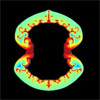CXC Home | Search | Help | Image Use Policy | Latest Images | Privacy | Accessibility | Glossary | Q&A
Simulation of Kepler supernova explosion
Quicktime MPEG
This video shows a simulation of the Kepler supernova as it interacts with material expelled by the giant star companion to the white dwarf before the latter exploded. It was assumed that the bulk of this material was expelled in a disk-like structure, with a gas density that is ten times higher at the equator, running from left to right, than at the poles. The colors represent the density of the gas, using a rainbow distribution, with red showing the highest densities, followed by orange, yellow and green, then blue showing the lowest densities. Note the dense structure on the left and right of the explosion. This simulation was performed in two dimensions, so this is a cross-section of the explosion. The simulation has to be projected into three dimensions to compare with observations. The good agreement with Chandra and Spitzer data supports the author's interpretation of the disk-like structure they observed.
[Runtime: 00:13]
Quicktime MPEG
This video shows a simulation of the Kepler supernova as it interacts with material expelled by the giant star companion to the white dwarf before the latter exploded. It was assumed that the bulk of this material was expelled in a disk-like structure, with a gas density that is ten times higher at the equator, running from left to right, than at the poles. The colors represent the density of the gas, using a rainbow distribution, with red showing the highest densities, followed by orange, yellow and green, then blue showing the lowest densities. Note the dense structure on the left and right of the explosion. This simulation was performed in two dimensions, so this is a cross-section of the explosion. The simulation has to be projected into three dimensions to compare with observations. The good agreement with Chandra and Spitzer data supports the author's interpretation of the disk-like structure they observed.
[Runtime: 00:13]
(Credit: NASA/CXC/NCSU/J.Blondin et al.)
Tour of Kepler's Supernova Remnant
Quicktime MPEG With closed-captions (at YouTube)
Over 400 years ago, Johannes Kepler and many others witnessed the appearance of a new "star" in the sky. Today, this object is known as the Kepler supernova remnant. For some time, astronomers have thought that the Kepler remnant comes from a so-called Type Ia supernova. These supernovas are the result of a thermonuclear explosion of a white dwarf. However, there is an ongoing controversy about Type Ia supernovas. Are they caused by a white dwarf pulling so much material from a companion star that it becomes unstable and explodes? Or do they result from the merger of two white dwarfs? New Chandra images reveal a disk-shaped structure near the center of the remnant. Researchers interpret this X-ray emission to be caused by the collision between supernova debris and disk-shaped material that a giant star expelled before the explosion. This and other pieces of evidence suggest that at least the Type Ia explosion that created Kepler was not the result of a merger between white dwarfs. Since these supernovas are used to measure the expansion of the Universe itself, astronomers are eager to understand them inside and out.
[Runtime: 01:26]
Quicktime MPEG With closed-captions (at YouTube)
Over 400 years ago, Johannes Kepler and many others witnessed the appearance of a new "star" in the sky. Today, this object is known as the Kepler supernova remnant. For some time, astronomers have thought that the Kepler remnant comes from a so-called Type Ia supernova. These supernovas are the result of a thermonuclear explosion of a white dwarf. However, there is an ongoing controversy about Type Ia supernovas. Are they caused by a white dwarf pulling so much material from a companion star that it becomes unstable and explodes? Or do they result from the merger of two white dwarfs? New Chandra images reveal a disk-shaped structure near the center of the remnant. Researchers interpret this X-ray emission to be caused by the collision between supernova debris and disk-shaped material that a giant star expelled before the explosion. This and other pieces of evidence suggest that at least the Type Ia explosion that created Kepler was not the result of a merger between white dwarfs. Since these supernovas are used to measure the expansion of the Universe itself, astronomers are eager to understand them inside and out.
[Runtime: 01:26]
(Credit: NASA/CXC/A. Hobart)
Kepler: The Star That Lived Two Lives
Quicktime MPEG With closed-captions (at YouTube)
In 1604, a new star appeared in the night sky. It shone brighter than all the other stars, and for three weeks, it was even visible during the day! This mysterious beacon marked the explosive death of a nearby star. These explosions are called supernovas, and they give off so much light that for a few weeks, they can outshine a galaxy of billions of stars! Then, slowly they fade away, leaving behind beautiful glowing clouds of gas, like the one in this picture. But let's travel back to a few million years earlier, because the story of this star gets even more interesting. The star that exploded in 1604 began its life as an average star, similar to our Sun. When an average-sized star dies, the result is much less dramatic than a powerful supernova. Instead of exploding, it expands to become a red giant and then collapses. The material from the centre of the star ends up squashed tightly down into a tiny, heavy ball called a white dwarf star. This is how this star died for the first time, long before 1604. But how did it end up dying a second time? Well, astronomers have recently discovered the answer to that question. The white dwarf had a companion, an enormous red giant star. Even though the red giant was much larger, the white dwarf's gravity was much stronger. It began to rip gas off its companion, pulling the material onto itself. Eventually the star's own greed led to its demise. It stole so much material that it became unstable, leading to the spectacular explosion that our ancestors saw!
[Runtime: 02:29]
Quicktime MPEG With closed-captions (at YouTube)
In 1604, a new star appeared in the night sky. It shone brighter than all the other stars, and for three weeks, it was even visible during the day! This mysterious beacon marked the explosive death of a nearby star. These explosions are called supernovas, and they give off so much light that for a few weeks, they can outshine a galaxy of billions of stars! Then, slowly they fade away, leaving behind beautiful glowing clouds of gas, like the one in this picture. But let's travel back to a few million years earlier, because the story of this star gets even more interesting. The star that exploded in 1604 began its life as an average star, similar to our Sun. When an average-sized star dies, the result is much less dramatic than a powerful supernova. Instead of exploding, it expands to become a red giant and then collapses. The material from the centre of the star ends up squashed tightly down into a tiny, heavy ball called a white dwarf star. This is how this star died for the first time, long before 1604. But how did it end up dying a second time? Well, astronomers have recently discovered the answer to that question. The white dwarf had a companion, an enormous red giant star. Even though the red giant was much larger, the white dwarf's gravity was much stronger. It began to rip gas off its companion, pulling the material onto itself. Eventually the star's own greed led to its demise. It stole so much material that it became unstable, leading to the spectacular explosion that our ancestors saw!
[Runtime: 02:29]
(Credit: NASA/CXC/A. Hobart)
Return to Kepler's Supernova Remnant (March 18, 2013)





